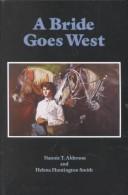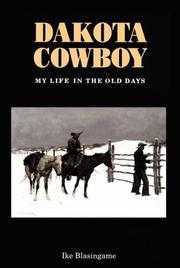| Listing 1 - 10 of 462 | << page >> |
Sort by
|

ISBN: 080325234X 0585312524 9780585312521 0803250010 9780803250017 Year: 1969 Publisher: Lincoln Univ. of Nebraska Press
Abstract | Keywords | Export | Availability | Bookmark
 Loading...
Loading...Choose an application
- Reference Manager
- EndNote
- RefWorks (Direct export to RefWorks)
A Bride Goes West is new and fresh because it is impregnated with a just sense of values about life. When Nannie Tiffany of West Virginia married Walt Alderson, who'd already been on the cattle trail for years, in 1882, they went to Montana to start a little ranch. There's plenty about ranching in this book but what is most valuable is about life, about people in this ranch country.
Book
ISBN: 0803274777 9780803274778 Year: 1999 Publisher: Lincoln
Abstract | Keywords | Export | Availability | Bookmark
 Loading...
Loading...Choose an application
- Reference Manager
- EndNote
- RefWorks (Direct export to RefWorks)
Book
ISBN: 9781772032314 177203231X 9781772032307 1772032301 Year: 2018 Publisher: Victoria ; Vancouver ; Calgary : Heritage House,
Abstract | Keywords | Export | Availability | Bookmark
 Loading...
Loading...Choose an application
- Reference Manager
- EndNote
- RefWorks (Direct export to RefWorks)
Book
Year: 2017 Publisher: [Place of publication not identified] : Great Neck Publishing,
Abstract | Keywords | Export | Availability | Bookmark
 Loading...
Loading...Choose an application
- Reference Manager
- EndNote
- RefWorks (Direct export to RefWorks)
Book
ISBN: 1477301879 Year: 1962 Publisher: Austin, Texas : University of Texas Press,
Abstract | Keywords | Export | Availability | Bookmark
 Loading...
Loading...Choose an application
- Reference Manager
- EndNote
- RefWorks (Direct export to RefWorks)
The gold rush was Herman Francis Reinhart's life for almost twenty years. From the summer of 1851 when, as a boy in his late teens, he traveled the Oregon trail to California, until a January day in 1869 when he climbed aboard an eastbound train at Evanston, Wyoming, he was a part of every gold discovery that stirred the West. Reinhart dipped his pan in the streams of northern California and western Oregon—in Humbug Creek, Indian Creek, Rogue River, and Sucker Creek. He made the arduous and dangerous overland journey through Indian-occupied western Washington and British Columbia to find the Fraser River gold even more elusive than that farther south. With his teams and wagons he traversed all of the inland mine areas from Walla Walla to Fort Benton, from Boise Basin to South Pass City. Reinhart's German common sense soon turned him from actual mining to other sources of income, but whatever his labor was, the mines were always the focal point of his activities. When he operated a bakery and saloon it was a business whose customers were miners, whose transactions were more likely to involve gold dust than legal tender, and whose gambling tables saw the exchange of mining fortunes. When he operated a whipsaw mill the timbers cut there were used by miners for sluices and cradles. For a while Reinhart farmed, but planting and harvesting suffered from interruption by frequent expeditions to the mines. And when he prospered as a teamster it was to and from the mining towns that he hauled passengers, supplies, and equipment. The men who, like Herman Francis Reinhart, hopefully followed the golden frontier were not an articulate group, and the written records of their lives are few and fragmentary. But Reinhart, in his later years, recorded his experiences in five long, narrow, hardback ledgers. Many years after he died his daughter gave the ledgers to a friend in Chanute, Kansas—Nora Cunningham—who read the narrative, became fascinated by it, and typed it for publication. Reinhart's account, written in a grammar and language all his own, is not a record of the historian's West, but of the West of the individual miner. The pages are filled with the details of day-to-day life of the miners—the subjects that interested them, the problems that plagued them, their fun and feuding, their frustrations and hopes. Edited by an authority of the history of the West, it is a book that will offer exciting reading to casual readers and scholars alike.
Book
ISBN: 9781477301876 1477301879 9780292741584 0292741588 Year: 2021 Publisher: Austin
Abstract | Keywords | Export | Availability | Bookmark
 Loading...
Loading...Choose an application
- Reference Manager
- EndNote
- RefWorks (Direct export to RefWorks)
The gold rush was Herman Francis Reinhart's life for almost twenty years. From the summer of 1851 when, as a boy in his late teens, he traveled the Oregon trail to California, until a January day in 1869 when he climbed aboard an eastbound train at Evanston, Wyoming, he was a part of every gold discovery that stirred the West. Reinhart dipped his pan in the streams of northern California and western Oregon—in Humbug Creek, Indian Creek, Rogue River, and Sucker Creek. He made the arduous and dangerous overland journey through Indian-occupied western Washington and British Columbia to find the Fraser River gold even more elusive than that farther south. With his teams and wagons he traversed all of the inland mine areas from Walla Walla to Fort Benton, from Boise Basin to South Pass City. Reinhart's German common sense soon turned him from actual mining to other sources of income, but whatever his labor was, the mines were always the focal point of his activities. When he operated a bakery and saloon it was a business whose customers were miners, whose transactions were more likely to involve gold dust than legal tender, and whose gambling tables saw the exchange of mining fortunes. When he operated a whipsaw mill the timbers cut there were used by miners for sluices and cradles. For a while Reinhart farmed, but planting and harvesting suffered from interruption by frequent expeditions to the mines. And when he prospered as a teamster it was to and from the mining towns that he hauled passengers, supplies, and equipment. The men who, like Herman Francis Reinhart, hopefully followed the golden frontier were not an articulate group, and the written records of their lives are few and fragmentary. But Reinhart, in his later years, recorded his experiences in five long, narrow, hardback ledgers. Many years after he died his daughter gave the ledgers to a friend in Chanute, Kansas—Nora Cunningham—who read the narrative, became fascinated by it, and typed it for publication. Reinhart's account, written in a grammar and language all his own, is not a record of the historian's West, but of the West of the individual miner. The pages are filled with the details of day-to-day life of the miners—the subjects that interested them, the problems that plagued them, their fun and feuding, their frustrations and hopes. Edited by an authority of the history of the West, it is a book that will offer exciting reading to casual readers and scholars alike.
Book
ISBN: 160938170X Year: 2013 Publisher: Iowa City, IA : University of Iowa Press,
Abstract | Keywords | Export | Availability | Bookmark
 Loading...
Loading...Choose an application
- Reference Manager
- EndNote
- RefWorks (Direct export to RefWorks)
"In on behalf of the family farm, Jenny Baker Devine demonstrates that in an era where technology, depopulation and rapid economic change dramatically altered rural life, Midwestern women met those challenges with an activism that reflected their own feminine vision of farm life. Focusing on women in four national farm organizations in Iowa -- the Farm Bureau, the Farmers Union, the National Farmers Organization, and the Porkettes -- Devine highlights specific movements in time when farm women had to reassess their roles and strategies for preserving and improving their way of life."

ISBN: 0803252447 9780803252448 0803250150 9780803250154 0803209061 9780803209060 Year: 1958 Publisher: Lincoln ; London : University of Nebraska Press,
Abstract | Keywords | Export | Availability | Bookmark
 Loading...
Loading...Choose an application
- Reference Manager
- EndNote
- RefWorks (Direct export to RefWorks)
When the most romantic of cow outfits, the British-owned Matador, shipped out from Texas with 3,000 head of cattle bound for Dakota and the Cheyenne Indian Reservation, an observant young bronc twister named Ike Blasingame rode with them. Dakota Cowboy-which the New York Times calls "warm, human, flavorful"-is the story of Ike's eight years (1904-1912) on the last of the great open ranges. Its pages "take the reader across the treacherous Missouri as the spring-softened ice goes out under the horses' feet, into the still wild cow towns, through the roundups, the prairie fire
Book
ISBN: 0803253036 Year: 1954 Publisher: Lincoln ; London : University of Nebraska Press,
Abstract | Keywords | Export | Availability | Bookmark
 Loading...
Loading...Choose an application
- Reference Manager
- EndNote
- RefWorks (Direct export to RefWorks)
During the depression days of the early 1930s the Jordan family-Len Jordan (later governor of Idaho and a United States senator), his wife Grace, and their three small children-moved to an Idaho sheep ranch in the Snake River gorge just below Hell's Canyon, the deepest scratch on the face of North America. ""Cut off from the world for months at a time, the Jordans became virtually self-sufficient. Short of cash but long on courage, they raised and preserved their food, made their own soap, and educated their children.""-Sterling North, New York World-Telegram ""Home Bel
Book
ISBN: 1282654381 9786612654381 0299247538 9780299247539 0299247546 9780299247546 9780299247546 Year: 2010 Publisher: Madison, Wis. : Terrace Books,
Abstract | Keywords | Export | Availability | Bookmark
 Loading...
Loading...Choose an application
- Reference Manager
- EndNote
- RefWorks (Direct export to RefWorks)
Plum Falls, New York, 1840s: Dismissed from Harvard Divinity School for his liberal views, Increase Joseph Link arrives home with a heavy heart. He gives up his dream of becoming a minister to settle for life on the farm, until the day he is struck by lightning and hears a voice telling him to rise and speak. Heeding that voice, Increase becomes a preacher, advocating for environmental protection and the end of slavery and war. His growing band of followers calls itself the Standalone Fellowship, and they accompany him on his move west to Wisconsin, to a place of better land and opportunity. Link Lake, Wisconsin, 1852: Preacher Increase Link and the Standalone Fellowship settle near a lake that they name in his honor. Increase's gifted tongue calls people to his mission to protect the land: "Unless we take care of the land we shall all perish." To finance the fellowship activities, Increase sells his special cure-all tonic--fifty cents per bottle! Inspired by actual events that took place in upstate New York and Wisconsin in the mid-nineteenth century, The Travels of Increase Joseph is the first in Jerry Apps's series set in fictional Ames County, Wisconsin. The four novels in the series--which also includes In a Pickle, Blue Shadows Farm, and the forthcoming Cranberry Red--all take place around Link Lake at different points in history. They convey Apps's deep knowledge of rural life and his own concern for land stewardship.
Clergy --- Lightning --- Frontier and pioneer life --- Wisconsin
| Listing 1 - 10 of 462 | << page >> |
Sort by
|

 Search
Search Feedback
Feedback About UniCat
About UniCat  Help
Help News
News